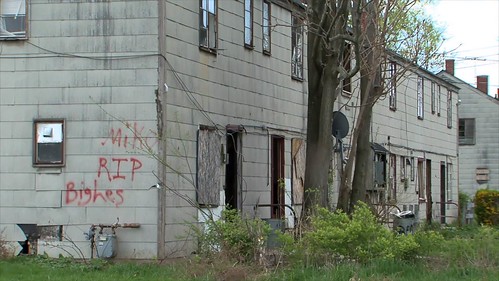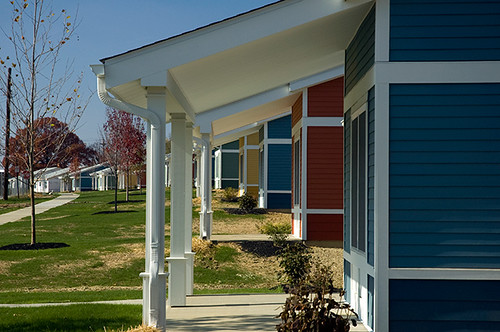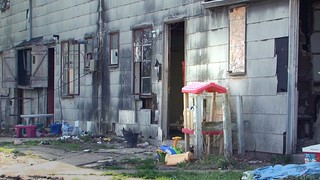The challenging transformation of Valley Homes: from decay to the beginnings of community

Posted September 17, 2012 at 1:28PM
Lincoln Heights, Ohio, is about a dozen miles north of Cincinnati. It contains around 4,500 residents, 98 percent of them African-American. In fact, according to a community website, it was the first self-governing African American community north of the Mason-Dixon Line and at one time the largest. But household income is low, and only about a third of the town’s single-family homes are owner-occupied.
What I will write here is really a set-up for the evocative video below. It shows the story of Valley Homes, a cooperatively owned housing project built in Lincoln Heights in 1942 that had become badly deteriorated, because mounting needed repairs to buildings that had been poorly constructed in the first place had become too numerous and too expensive for its low-income owners to undertake. In 2005 the property fell into receivership and two years later a task force was appointed to search for a permanent solution. The details of what happened over the next few years and the evolution of the project’s ownership and financial structure are complex.
But high on the list of task force goals were new senior housing and allowing current residents to stay. Eventually the old buildings were condemned and torn down, and the group selected a development firm named the Model Group to redevelop the site. The good news is that Valley Homes has now been replaced with a mix of updated and affordable housing types called Villas of the Valley, and the site is once again serving the community. Jay Springer elaborates on Cincinnati.com:
“The redevelopment of the site was identified as a top community priority in the Lincoln Heights Urban Renewal Plan and Revitalization Strategy of 2001. Model Group worked closely with the residents of the Valley Homes Redevelopment Task Force and the Lincoln Heights Planning Commission to develop designs appropriate and sensitive to the surrounding community. This development included the demolition of functionally obsolete, dilapidated housing and the construction of 42 new ranch-style, detached senior cottages, 35 two-story, attached rental units, and 4 single-family detached homes.
“Model Group’s effort to incorporate community feedback combined with key members of the Planning Commission publicly championing the project resulted in a transformational development for the Village of Lincoln Heights.”
The new development also includes a community center.
The change is certainly impressive and, in some respects, green. But it is not perfect: from the perspective of smart growth and city planning ideals, one can certainly find fault with the new neighborhood, which took a step back by replacing part of the traditional street grid with cul-de-sacs, and constructed fewer homes than the site once contained. I'm particularly disappointed that parts of the development appear even to lack sidewalks.  But this is not a major transit-oriented, affordable and mixed-use showcase with the impressive scale and urban detail of, say, Denver’s remarkable South Lincoln transformation. (It also hasn’t enjoyed the focus and assistance of multiple federal agencies, as has that project.) Nor does it contain the sparkling green ambition of, for example, Seattle’s High Point. The financing appears to have been challenging, to say the least.
But this is not a major transit-oriented, affordable and mixed-use showcase with the impressive scale and urban detail of, say, Denver’s remarkable South Lincoln transformation. (It also hasn’t enjoyed the focus and assistance of multiple federal agencies, as has that project.) Nor does it contain the sparkling green ambition of, for example, Seattle’s High Point. The financing appears to have been challenging, to say the least.
No, this is a much smaller and more modest project, but one no less important to its community and certainly no less significant to its residents, whose lives it has vastly improved. You would have to be blind not to see the dramatic improvement. It looks terrific to my eye, suggesting some of the first, more densely populated inner suburbs in the US before the McMansion era took over. (The average size of a home in the Villas is said to be around 1,000 square feet.) The story here is that redevelopment happened at all – this was not a case where that could be taken for granted – and that Lincoln Heights is better for it.
Villas of the Valley does have transit access, as well as environmentally friendly construction and building features, including energy efficiency, designed to the standards of the well-known Green Communities Program of Enterprise Community Partners (NRDC was an early partner in that program's development). It will have a community garden. The project’s architects, City Studios, also report that “all of the residents that chose to were able to remain in the neighborhood throughout the duration of the construction process.” (I liked what I saw of the City Studios website, describing a young firm specializing in revitalization and adaptive reuse of historic properties and based in Cincinnati’s historic, revitalizing Over-the-Rhine neighborhood.)
There is also a possibility, according to reports, that the Model Group will add more development to the project by building on adjacent parcels. I hope they do (with more sidewalks and without cul-de-sacs this time), because more intensity and connectivity would make the neighborhood more walkable and perhaps begin to support some modest neighborhood-serving retail and/or small businesses. This could strengthen the sense of community that the Villas have already begun to instill.
This three-minute video is silent but captivating and extremely well produced. I suspect that words would only get in the way:
Related posts:
- Bank of America supports affordable green neighborhoods with grant program (June 1, 2012)
- The right approach to green, inclusive revitalization (May 10, 2012)
- A remarkable grassroots revitalization matures and thrives in Boston (March 26, 2012)
- "Katrina Cottages" find post-Katrina uses as affordable housing, educational facilities, offices, & more (July 11, 2011)
- Financial Opportunity Centers help transform distressed areas into stronger communities (July 23, 2010)
- Tassafaronga Village brings affordable gold and platinum to East Oakland (June 30, 2010)
- Streets for seniors: a video look at issues and remedies (July 1, 2009)
Move your cursor over the images for credit information.



